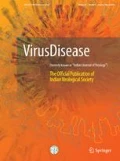Abstract
Chikungunya fever is an important reemerging arbovirus illness, which is transmitted by the same vector as of dengue virus. Many cases of concurrent infections with multiple dengue virus serotypes have been reported in many countries. Also, concurrent infection with Chikungunya virus and dengue virus has been reported in the past in Delhi. Therefore, this study was done to detect Chikungunya IgM antibodies in suspected dengue fever patients. In this study, 1666 serum samples suspected of dengue fever and collected during the outbreak period (August 2010–December 2010) were tested for dengue IgM antibodies, of which 736 tested negative. Of the 736 dengue IgM negative sera, 666 were tested for Chikungunya IgM antibodies. The demographic profile and essential laboratory investigations were recorded. Chikungunya IgM was detected in 9.91 % of the patients. During the post-monsoon period though dengue dominated in numbers, the number of Chikungunya fever cases increased gradually followed by an abrupt decrease with the onset of winter. The Chikungunya IgM positive patients were suffering from fever of more than 5 days duration and had thrombocytopenia. Due to similarity in clinical features and vector transmitting dengue and Chikungunya virus, continuous surveillance of both dengue fever and Chikungunya fever is desirable for better management and epidemiological assessment.

References
Afreen N, Deeba F, Khan WH, Haider SH, Kazim SN, Ishrat R, Naqvi IH, Shareef MY, Broor S, Ahmed A, Parveen S. Molecular characterization of dengue and chikungunya virus strains circulating in New Delhi, India. Microbiol Immunol. 2014;58(12):688–96.
Araújo FMC, Nogueira RMR, Araújo JMG, Ramalho ILC, Sá Roriz MLF, Melo MEL, Coelho ICB. Concurrent infection with dengue virus type-2 and DENV-3 in a patient from Ceará, Brazil. Mem Inst Oswaldo Cruz. 2006;101(8):925–8.
Arora BS, Chugh S, Gupta B, Aggarwal KC. Dengue and chikungunya virus fever outbreaks in Delhi, IG-M serology status—a recent experience. Natl J Basic Med Sci. 2012;2(4):336–40.
Bharaj P, Chahar HS, Pandey A, Diddi K, Dar L, Guleria R, Kabra SK, Broor S. Concurrent infections by all four dengue virus serotypes during an outbreak of dengue in 2006 in Delhi, India. Virol J. 2008;5:1. doi:10.1186/1743-422X-5-1.
Chahar HS, Bharaj P, Dar L, Guleria R, Kabra SK, Broor S. Co-infections with chikungunya virus and dengue virus in Delhi, India. Emerg Infect Dis. 2009;15(7):1077–80.
Chakravarti A, Matlani M, Kashyap B, Kumar A. Awareness of changing trends in epidemiology of dengue fever is essential for epidemiological surveillance. Indian J Med Microbiol. 2012;30(2):222–6.
Gubler DJ, Kuno G, Sather GE, Waterman SH. A case of natural concurrent human infection with two dengue viruses. Am J Trop Med Hyg. 1985;34(1):170–3.
Lahariya C, Pradhan SK. Emergence of chikungunya virus in Indian subcontinent after 32 years: a review. J Vect Borne Dis. 2006;43(4):151–60.
Mavalankar D, Shastri P, Bandyopadhyay T, Parmar J, Ramani KV. Increased mortality rate associated with chikungunya epidemic, Ahmedabad, India. Emerg Infect Dis. 2008;14(3):412–5.
Myers RM, Carey DE. Concurrent isolation from patient of two arboviruses, chikungunya and dengue type 2. Science. 1967;157(3794):1307–8.
Nagpal BN, Saxena R, Srivastava A, Singh N, Ghosh SK, Sharma SK, Kumar A, Kumar H, Sharma AS, Chand SK, Ojha VP, Mohanty SS, Mohanty AK, Dasgupta RK, Dhillon GPS, Dash AP. Retrospective study of chikungunya outbreak in urban areas of India. Indian J Med Res. 2012;135:351–8.
Rocco IM, Barbosa ML, Kanomata EH. Simultaneous infection with dengue 1 and 2 in a Brazilian patient. Rev Inst Med Trop Sao Paulo. 1998;40(3):151–4.
Saswat T, Kumar A, Kumar S, Mamidi P, Muduli S, Debata NK, Pal NS, Pratheek BM, Chattopadhyay S. High rates of co-infection of dengue and chikungunya virus in Odisha and Maharashtra, India during 2013. Infect Genet Evol. 2015;35:134–41.
Singh P, Mittal V, Rizvi MM, Chhabra M, Sharma P, Rawat DS, Bhattacharya D, Chauhan LS, Rai A. The first dominant co-circulation of both dengue and chikungunya viruses during the post-monsoon period of 2010 in Delhi, India. Epidemiol Infect. 2012;140(7):1337–42.
Singh P, Mittal V, Rizvi MA, Bhattacharya D, Chhabra M, Rawat DS, Icchpujani RL, Chauhan LS, Rai A. Northward movement of East Central South African Genotype of Chikungunya virus causing an epidemic between 2006–2010 in India. J Infect Dev Ctries. 2012;6(7):563–71.
Staples JE, Breiman RF, Powers AM. Chikungunya fever: an epidemiological review of a re-emerging infectious disease. Clin Infect Dis. 2009;49:942–8.
Stoddard ST, Morrison AC, Vazquez-Prokopec GM, Soldan VP, Kochel TJ, Kitron U, Elder JP, Scott TW. The role of human movement in the transmission of vector-borne pathogens. PLoS Negl Trop Dis. 2009;3(7):e481. doi:10.1371/journal.pntd.0000481.
Vazeille M, Mousson L, Martin E, Failloux AB. Orally co-infected Aedes albopictus from La Reunion Island, Indian Ocean, can deliver both dengue and chikungunya infectious viral particles in their saliva. PLoS Negl Trop Dis. 2010;4(6):e706. doi:10.1371/journal.pntd.0000706.
Author information
Authors and Affiliations
Corresponding author
Rights and permissions
About this article
Cite this article
Ramachandran, V.G., Das, S., Roy, P. et al. Chikungunya: a reemerging infection spreading during 2010 dengue fever outbreak in National Capital Region of India. VirusDis. 27, 183–186 (2016). https://doi.org/10.1007/s13337-016-0314-z
Received:
Accepted:
Published:
Issue Date:
DOI: https://doi.org/10.1007/s13337-016-0314-z

